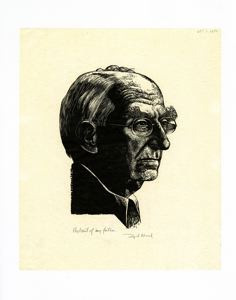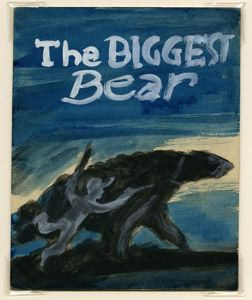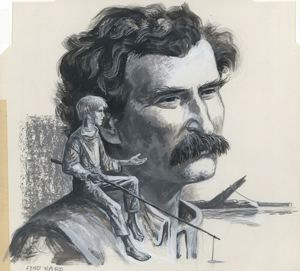Introduction:
The decision made by Lynd Ward and his wife, writer May McNeer Ward, to donate his personal papers to Georgetown makes available to students of American art, history, and literature the nearly complete record of a remarkable lifetime achievement. Whether as author-artist-printmaker, officer of arts organizations, or founder and guiding spirit of a cooperative small press, Ward has translated his strongly held personal values into a significantly rich and varied body of work.
This exhibit draws heavily on the more than 1,000 paintings, drawings, prints, sketches and proofs donated by the artist's daughters. These provide visual documentation of the history of Ward's life as revealed in the papers. Yet in fact the 44 originals shown do little more than suggest the wealth of the collection. The letters and papers shown here highlight the conditions in which Ward has worked, a few of his relationships with authors and editors, and the wide acclaim the public has given him for his efforts.
Ward's reputation was first made by the series of woodcut novels (from Gods' Man to Vertigo) which he produced during the years 1929 to 1937. The Wards' gift of the surviving 21 wood-engraved blocks for Song Without Words, three of which are displayed, provides the clearest possible demonstration of his great skill in the medium with which his name is most often linked.
Finally, this is the first time such an extensive, if not comprehensive, survey of Ward's work has been exhibited. A number of the wood-engravings and lithographs, including the 1945 self portrait for the National Academy of Design, were never printed in even very small editions. Thanks to the generosity of the artist and his family, a significant segment of his life's work will be maintained together as a resource for scholars, for connoisseurs, and for students.
Items in the Exhibition:
"Self Portrait"
Wood engraving, 262 x 203 mm, 1945, signed at lower right. Executed for submission upon the artist's election to the National Academy of Design.
"The Biggest Bear"
Gouache drawing on Board for Ward's The Biggest Bear (Houghton Mifflin, 1952), one of the most famous of the author's works for children and the one for which he received the Caldecott Award.
Mark Twain
Crayon, ink, and gouache on board portrait of Mark Twain, an illustration for May McNeer's America's Mark Twain (Houghton Mifflin, 1962).
Bibliognost
May, 1976.
Volume 2, number 2, with 10 articles devoted to various aspects of Ward's life and work.
Self portrait
Pencil on paper, sketch for the Cape and Smith promotional portrait.
Self portrait
Wood engraving, 153 x 102 mm, ca. 1930, signed at lower right, one of an edition of 100 copies printed from the original block.
Photograph of May Yonge McNeer
1921 or 1922.
Photograph of Lynd and May Ward
At the family vacation home in Canada, probably taken during the summer of 1927.
"The Silver Pony"
Ink and gouache drawing on board for Ward's The Silver Pony (Houghton Mifflin, 1973), a story for children told entirely in pictures.
A pair of letters
A pair of letters from young autograph collectors, occasioned by reading Ward's The Biggest Bear.
Autograph collecting on a higher level
Autograph collecting on a higher level: two letters (21 May and 10 June 1968) from Lynda Johnson Robb to Ward about inscribing a copy of The Biggest Bear.
Columbia University and the Academy in Leipzig
Lynd Ward studied art at Columbia University, where he became editor of the Columbia Jester in 1925-1926, and at the Academy in Leipzig, where he was a special student in the graphic arts.
"Columbia Jester" December 1925 and February 1926
The December, 1925, and February, 1926, issues of the Columbia Jester, both with cover illustrations by Ward.
Untitled lithograph
250 x 353 mm, 13/21 copies, signed at lower right. Done in Leipzig, ca. 1927.
Untitled soft ground etching
150 x 214 mm, 1/50 copies, signed at lower right. Done in Leipzig, ca. 1927.
Wood engraved narratives
The artist's reputation in intellectual circles was "made" by the series of wood engraved narratives produced between 1929 and 1937. Over the years his work became freer, dropping first the artificial borders and later the rigid rectangular format of the block.
"Gods' Man: A Novel in Woodcuts"
(Cape and Smith, 1929)
Copy 99 of the edition of 409 copies printed from the original blocks and signed by the artist. With a proof signature from section III of the story.
Early Fan Letter
An early fan letter from a lady with reptiles; Ward also achieved fame in non-intellectual circles.
"Madman's Drum"
Rejected block for the image shown in Madman's Drum: the innocence of the young boy has been emphasized. Loaned by Penelope C. and George M. Barringer.
"Madman's Drum: A Novel in Woodcuts"
Madman's Drum: A Novel in Woodcuts (Cape and Smith, 1930). Unnumbered copy, of an edition of 309 copies printed from the original blocks and signed by the artist. Loaned by Penelope C. and George M. Barringer.
"Wild Pilgrimage"
Wild Pilgrimage (Smith and Haas, 1932). First edition. Loaned by Penelope C. and George M. Barringer.
"Song Without Words"
Song Without Words: A Book of Engravings on Wood (Random House, 1936). Copy 1083 of the edition of 1250 copies printed from the original blocks and signed by the artist. Loaned by Penelope C. and George M. Barringer.
Original Blocks
Three of the 21 surviving original blocks for Song Without Words. Gift of the artist, 1982.
"Vertigo"
Vertigo: A Novel in Woodcuts (Random House, 1937). First edition. With a rejected block for the image shown; emphasis changed to the young man. Loaned by Penelope C. and George M. Barringer.
Equinox Cooperative Press
Ward was among the founders of the Equinox Cooperative Press, a democratically-run, craft-oriented small press that produced a series of artistically distinctive, as well as socially significant, volumes during the Depression years 1932 to 1939.
"Now That the Gods Are Dead"
The first Equinox book (1932) was Llewellyn Powys' Now That the Gods are Dead, with four wood engravings by Ward. It was one of the AIGA "Fifty Books" of the year. Copy 230 of an edition of 400 signed by author and artist. Loaned by Penelope P. and George M. Barringer.
Card from Llewellyn Powys
Card from Llewellyn Powys to ward, 11 June 1932, acknowledging Ward's titling of Powys's essay: "The title you have chosen satisfies me—I think it a good one."
Prospectus
Original printed prospectus for the Equinox Cooperative Press, offering subscribers discounts on a "consumer-membership plan."
"Prelude to a Million Years"
Prelude to a Million Years: A Book of Wood Engravings (Equinox, 1933) was the only "woodcut novel" of Ward's released through Equinox. Copy 916 of the edition of 920 copies printed from the original blocks and signed by the artist. Loaned by Penelope C. and George M. Barringer.
Granville Hicks
Granville Hicks contributed a series of prose sketches to accompany Ward's biography-in-lithographs One of Us: The Story of John Reed (Equinox, 1935). Presentation copy from Ward to his attorney, Arthur Donigian. Loaned by Penelope C. and George M. Barringer.
Notes for "One of Us"
The artist's rough notes for sources and ordering the lithographs in One of Us.
Letter from Thomas Mann
Carbon of copy of a letter from Thomas Mann to the Equinox Press, 6 September 1933, discussing terms and the title for Nocturnes.
"Nocturnes"
Ward contributed seven lithographs to Thomas Mann's Nocturnes (Equinox, 1934), the first appearance in English of three of his short stories, produced in an edition of 1,000 copies signed by the author.
Certificate of Incorporation
Ward's retained draft of the Equinox "Certificate of Incorporation," with his autograph corrections.
"A Relevant Memoir"
Henry Hart's A Relevant Memoir: The Story of the Equinox Cooperative Press (Three Mountains Press, 1977), with a foreword by Ward, provides a vivid account of the press's politics and progress, as well as a detailed bibliography of its output.
May McNeer
Ward's collaboration with his wife, May McNeer, has been a long and fruitful one spanning more than four decades in which he has illustrated books for children written by her.
"Give Me Freedom"
Ink and gouache drawing on board for May McNeer's Give Me Freedom (Abingdon, 1964).
"Waif Maid"
Four-color wood engraving, 140 x 96 mm, created as the frontispiece illustration for May McNeer's Waif Maid (Macmillan, 1930). The artist's only attempt at full color wood engraving.
"The Wolf of Lamb's Lane"
Ink and gouache drawing on board for May McNeer's The Wolf of Lamb's Lane (Houghton Mifflin, 1967).
"Stranger in the Pines"
First edition of May McNeer's Stranger in the Pines (Houghton Mifflin, 1971), with illustrations by Ward. Loaned by Nicholas B. Scheetz.
Typescript of "Stranger in the Pines"
First typescript with autograph revisions, 1969, of May McNeer's Stranger in the Pines, published by Houghton Mifflin in 1971 with the first five chapters dropped and the remainder much rewritten.
"Prince Bantam"
Watercolor painting on board, frontispiece illustration for May McNeer's Prince Bantam (Macmillan, 1929), the first book on which husband and wife collaborated.
"America's Abraham Lincoln"
Argentine Spanish-language text of America's Abraham Lincoln (1959), reproducing many more of Ward's illustrations than do the Burmese and Bengali versions also shown.
"America's Abraham Lincoln" in Burmese and Bengali
May McNeer's America's Abraham Lincoln (Houghton Mifflin, 1957) with illustrations by Ward. These editions, in Burmese (1959) and Bengali (1960) sponsored by the U.S. Information Service, have cover art done locally copying or based loosely on, Ward's published illustrations.
Artwork "for free"
Throughout his career Ward has willingly associated himself with groups seeking to better man's lot, whether motivated by religious or materialistic reasons. He has done copious artwork "for free" and has served as an officer in numerous organizations of artists.
Cartoon
Wood engraved cartoon, 165 x 158 mm, 1946, signed at lower right. For the 30 December 1946 issue of New Republic. The New Year's message is obvious.
"Portrait of Henry Wallace"
Wood engraving, 253 x 178 mm, 1946, signed at the lower right. An illustration for the 16 December 1946 issue of New Republic.
"The Risen Soldier"
Ward did the cover art (though not the lettering ) for Cardinal Spellman's The Risen Soldier (Catechetical Guild Education Society, 1953).
Letter from Francis A. Henson
Letter from Francis A. Henson, executive secretary of the National Religion and Labor Foundation, 27 October 1932, thanking Ward for agreeing to do art work for the group's bulletin and commenting on its earlier use of a piece by Art Young.
"Let Southern Labor Speak"
Ward contributed the cover design and lettering for Let Southern Labor Speak (1938), a publication of the Highlander Folk School, Monteagle, Tennessee: "...it gives some indication of the fight that southern workers are making to build a labor movement to end exploitation and injustice."
"Soviet Russia Today"
Ink and charcoal drawing on board for the magazine Soviet Russia Today, ca. 1942-45.
Card from Mr. and Mrs. Rockwell Kent
Card from Mr. and Mrs. Rockwell Kent, ca. 1945-46. Kent has added in his own hand: "Please be sure and have A.L.A. (Artists League of America ) send its blessings to these young ambassadors. Maybe your father will too."
"In Place of Profit"
Ward produced a number of lithographic illustrations for his father's In Place of Profit: Social Incentives in the Soviet Union (Scribner's, 1933).
Limited Editions Club
Much of the artist's best known illustrative work was done for George Macy's Limited Editions Club and its Heritage Club offshoot with which Ward was associated for over 40 years.
"Pettifoggers"
Charcoal sketch on paper for plate five, "Pettifoggers," in Moriae Encomium: "Consequently the lawyer piles up a fortune while the theologian, having digested the whole body of divinity, sits gnawing a crust."
"Moriae Encomium"
Erasmus's Moriae Encomium; or, The Praise of Folly (Limited Editions Club, 1943), fulfilled one of Ward's earliest ambitions: to illustrate a volume with mezzotints printed from the original plates. Loaned by Penelope C. and George M. Barringer.
"Rights of Man"
Thomas Paine's Rights of Man (Limited Editions Club, 1961), illustrated by Ward with two-color lithographs. Loaned by Penelope C. and George M. Barringer.
"The Count of Monte Cristo"
Ink drawing on watercolor paper for an illustration for Alexander Dumas's The Count of Monte Cristo (Limited Editions Club, 1941).
Higgins Ink Advertisement
Proof of a Higgins Ink advertisement, 1947, claiming a share of the credit for Ward's drawings for The Count of Monte Cristo.
"Gargantua and Pantagruel"
Ink drawing on board for the frontispiece to Book I of Rabelais's Gargantua and Pantagruel (Heritage, 1942). This drawing was used as a full-page illustration in David Bland's A History of Book Illustration (World, 1958).
Letter from George Macy
Letter from George Macy to the artist, 13 March 1942, referring to a number of Ward's commissions including the Rabelais, Hemingway, and Dumas publications.
For Whom the Bell Tolls
Artist's dummy (incomplete), various media, for Ernest Hemingway's For Whom the Bell Tolls (Limited Editions Club, 1942).
"Anselmo"
Lithograph, 177 x 148 mm, 1942, signed at lower right. Stone proof impression of an illustration for For Whom the Bell Tolls.
Book of Giants
Ink drawing on board for a "Book of Giants," ca. 1935. This is one of only a few drawings completed for the book, which was abandoned.
The Cloister and the Hearth
Ink and charcoal drawing, an illustration for Charles Reade's The Cloister and the Hearth (Limited Editions Club, 1932). The illustrations were reproduced in photogravure.
Moloch
Because he acknowledged Ward's influence on his work, Allen Ginsberg especially wanted the artist to illustrate his Moloch (Penmaen Press, 1978), a section of Howl here republished separately. One of 300 copies signed by author and artist.
A Cup of Sky
Color gouache painting on board for the dust jacket of Donald Culross and Noel Peattie's A Cup of Sky (Houghton Mifflin, 1950).
America's Robert E. Lee
Portrait of Robert E. Lee, oil on panel, 387 x 355 mm, an illustration for Henry Steele Commager's America's Robert E. Lee (Houghton Mifflin, 1951).
The Motives of Nicholas Holtz
Offset lithographic proof, in green, of the frontispiece to Thomas Painter and Alexander Laing's The Motives of Nicholas Holtz (Farrar & Rinehart, 1936), with a copy of the book as published and a specimen (trial proof (?) in green) of the dust jacket.
"North Star Shining"
Opaque watercolor drawing on board for an illustration in Hildegarde Hoyt Swift's North Star Shining (William Morrow, 1947), with a copy of the book showing the much-altered final version.
America's Robert E. Lee
Artist's dummy, various media on board, for Henry Steele Commager's America's Robert E. Lee (Houghton Mifflin, 1951), with two finished ink and goauche drawings for the same work.
Letter from Henry Steele Commager
Short letter from Henry Steele Commager to the artist attempting to obtain original artwork for America's Robert E. Lee.
Midsummernight
Promotional broadside for Carl Wilhelmson's Midsummernight (Farrar & Rinehart, 1930), reproducing six of Ward's wood-engraved illustrations for the book.
Man with Four Lives
Watercolor drawing on paper, dust jacket design for William Joyce Cowen's Man with Four Lives. (Farrar & Rinehart, 1934).
Man with Four Lives dust jacket
Dust jacket for William Joyce Cowen's Man with Four Lives (Farrar & Rinehart, 1934). Such commission works (at $25 or $50 apiece) provided a goodly portion of the artist's income at the time.
"Pipelines"
Wood engraving, 152 x 175 mm, 1947, signed at lower right. The November image for the 1948 U.S. Pipe and Foundry Co. calendar, for which Ward provided the illustrations.
Engraving of Abraham Lincoln
Untitled two-color engraving of Abraham Lincoln, 38 x 105 mm, ca. 1946-48. One of a series done by Ward for OWI and published in U.S.A. magazine.
"Portrait of Somerset Maugham"
Two-color wood engraving, 139 x 205 mm, 1947, signed at lower right. One of a series of portraits commissioned as cover designs for Atlantic Monthly (Maugham appeared in January, 1948.)
Preliminary drawing for "Giant"
Ink and gouache preliminary drawing on board for the wood engraving "Giant," 1955.
"Giant"
Wood engraving, 405 x 142 mm, 1955, signed at lower right. Commissioned as a cover illustration for Atlantic Monthly, which finally used only head and shoulders.
"Genesis 32"
Wood engraving, 620 x 292 mm, 1967, signed at lower right.
"Prisoner"
Wood engraving, 476 x 309 mm, 1974, signed at lower right center.
"Pilgrim's Progress"
Wood engraving, 228 x 152 mm, 1939, signed and dated at lower right. In the artist's original presentation mat. Possibly conceived as an illustration for the periodical Social Frontier (later Frontiers of Democracy).
"Clouded Over"
Wood engraving, 152 x 226 mm, 1948, signed at lower right. The print won a purchase prize of $100 in the Sixth National Exhibition of Prints at the Library of Congress, 1948.
"Abandoned Right-of-Way"
Lithograph, 302 x 214 mm, probably 1951, signed at lower right.



